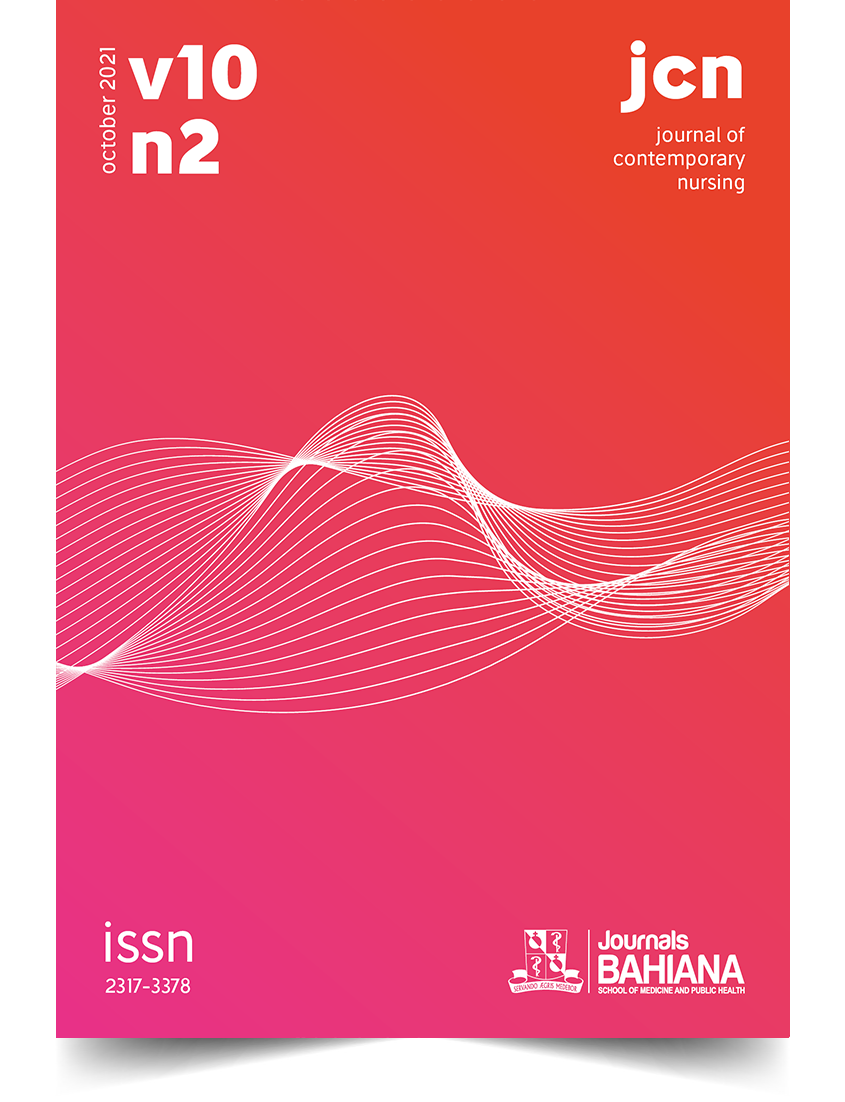Nursing diagnoses in neurological patients: a documentary study
DOI:
https://doi.org/10.17267/2317-3378rec.v10i2.4024Keywords:
Self-care. , Nursing Diagnosis. , Neurological disorder.Abstract
OBJECTIVE: to identify the sociodemographic and clinical profile and nursing diagnoses in neurological patients. METHOD: Documentary study carried out between December 2017 and March 2018, with 184 medical records in a tertiary hospital in the northeast region of Brazil. Data were collected using an instrument with a sociodemographic and clinical profile and presented through descriptive statistics. RESULTS: Most patients were male and medically diagnosed with traumatic brain injury. A total of 25 nursing diagnosis titles were observed, and the most prevalent were unstable blood glucose, acute confusion, falls, self-care deficit, impaired walking and impaired comfort. It is noticed the predominance of nursing diagnoses for neurological patients in the domains of nutrition and self-care. CONCLUSION: The nursing diagnoses identified in this study can contribute to the increase of sensitive indicators for nursing practice and favors assistance directed to the patient's needs.
Downloads
References
REFERÊNCIAS
Soares FMM, Pequeno CLD, Maia MP, Mariano MR, Abreu RNDC, Filho SPCS, et al. Clinical profile of patients hospitalized in neurology units. REAID. 2019;87(25)1-7. https://doi.org/10.31011/reaid-2019-v.87-n.especial-art.162
Santos DF, Padula MPC, Waters C. Nursing diagnoses of patients with ischemic stroke: a bibliographic research. Braz. J. Hea. Rev. 2020;3(1):644-72. https://doi.org/10.34119/bjhrv3n1-052
Lotufo PA, Goulart AC, Passos VMA, Satake FM, Souza MFM, França EB, et al. Cerebrovascular disease in Brazil from 1990 to 2015: Global Burden of Disease 2015. Rev. bras. epidemiol. 2017;20(suppl 1):129-41. https://doi.org/10.1590/1980-5497201700050011
Costa LR, Passos EV, Silvestre OM. Rediscovering Brazil: How We Prevent and Treat Cardiovascular Disease. Arq. Bras. Cardiol [Internet]. 2021;116(1):117-8. Disponível em: https://www.scielo.br/j/abc/a/JDGW77SwZ7Fp4Ld5RDvnrGS/?lang=pt
Almeida RGS, Mazzo A, Martins JCA, Jorge BM, Souza JVD, Mendes IAC. Self-confidence in the care of critically ill patients: before and after a simulated interven-tion. Rev. Bras. Enferm. 2019;72(6):1618-23. https://doi.org/10.1590/0034-7167-2018-0758
Taghavi LT, Saatchi B. Training of NANDA?I Nursing Diagnoses (NDs), Nursing Interventions Classification (NIC) and Nursing Outcomes Classification (NOC), in Psychiatric Wards: A randomized controlled trial. Nurs Open. 2019;6(2):612–9. https://doi.org/10.1002/nop2.244
Horta WA. Processo de enfermagem. São Paulo: EPU; 1979.
Alfaro-Lefevre R. Aplicação do processo de enfermagem: Fundamentos para o raciocínio clínico. 7ª ed. Porto Alegre: Artmed; 2010.
Nanda International Inc. Diagnósticos de enfermagem da NANDA: 2018-2020. Porto Alegre: Artmed; 2020.
Oliveira MIV, Bezerra Filho JG, Feitosa RFG, Sousa JEP. Risk factors and suicidal ideation in people who attempt suicide, Fortaleza, Ceará, Brazil. Rev Baiana Saúde Pública. 2020;12;42(2):262–79. https://doi.org/10.22278/2318-2660.2018.v42.n2.a2598
Oliveira J, Damasceno K, Souza L, Lima M. Clinical epidemiological profile and the main diagnostic labels nursing to hospitalized with stroke in a large hospital in the south of the Legal Amazon region. Amazônia Ciência & Saúde [Internet]. 2016;4(3):3–11. Disponível em: http://repositorio.facimed.edu.br/xmlui/handle/123456789/88
Ferreira AM, Rocha EN, Lopes CT, Bachion MM, Lopes JL, Barros ALBL. Nursing diagnoses in intensive care: cross-mapping and NANDA-I taxonomy. Rev Bras Enferm. 2016;69(2):285-93. http://dx.doi.org/10.1590/0034-7167.2016690214i
Silva V, Cruz I. Nursing evidence-based practice guidelines for blood glucose level in ICU - Systematic Literature Review. J. Spec. Nurs. Care [Internet]. 2020;12(1). Disponível em: http://www.jsncare.uff.br/index.php/jsncare/article/view/3273/819
Santos APL, Claudino LM, Pistori MÊS, Mezzomo TR. Quality indicators in nutritional therapy in a trauma intensive care unit, Curitiba, PR, Brazil. Nutr. clín. diet. hosp [Internet]. 2018;38(1):149-55. Disponível em: https://revista.nutricion.org/PDF/THAISREGINA.pdf
Bittencourt CM, Busanello J, Harter J, Garcia RP. Incidência de volume de líquidos excessivo em pacientes adultos sob cuidados intensivos. Cogitare Enferm. 2021;26.e72689. http://dx.doi.org/10.5380/ce.v26i0.72689
Guedes DMB, Rossato LM, Oliveira EA. The most frequent nursing diagnosis in pediatric intensive care unit. Rev enferm UFSM. 2015;5(3):476-85. http://dx.doi.org/10.5902/2179769216471
- Debone MC, Pedruncci ESN, Candido MCP, Marques S, Kusumota L. Nursing diagnosis in older adults with chronic kidney disease on hemodialysis. Rev. Bras. Enferm. 2017;70(4):800-5. https://doi.org/10.1590/0034-7167-2017-0117
- Hassan A, Mohamed H. Assessment of nurses’ knowledge and practice regarding fluids and electrolyte imbalance in critical care units. Port Said Scientific Journal of Nursing. 2021;8(2):1-13. https://dx.doi.org/10.21608/pssjn.2021.180999
Rosin J, Matos FGOA, Alves DCI, Carvalho ARS, Lahm JV. Identification of nursing diagnoses and interventions among neurological patients admitted to a teaching hospital. Ciênc cuid saúde. 2016;15(4):607-15 https://doi.org/10.4025/cienccuidsaude.v15i4.31167
Franco B, Busin L, Chianca TCM, Moraes VM, Pires AUB, Lucena AF. Association between Manchester Triage System discriminators and nursing diagnoses. Rev Gaúcha Enferm. 2018;39:e2017-0131. https://doi.org/10.1590/1983-1447.2018.2017-0131
Castellan C, Sluga S, Spina E, Sanson G. Nursing diagnoses, outcomes and interventions as measures of patient complexity and nursing care requirement in Intensive Care Unit. J adv nurs. 2016; 72(6):1273-86. https://doi.org/10.1111/jan.12913
Sousa L, Simões C, Araújo I. Prevenção da confusão aguda em doentes adultos internados em cuidados intensivos: Intervenções autónomas do enfermeiro. Revista Portuguesa de Enfermagem de Saúde Mental. 2019;(22):49-57. http://dx.doi.org/10.19131/rpesm.0263
Santos LF, Oliveira LMCO. Nursing diagnoses and interventions in families of hospitalized children. Revista Enfermagem UERJ. 2016;24(4):82-53. https://doi.org/10.12957/reuerj.2016.8253
Guerra AC, Rodrigues CVNR, Carmo DCA, Cruz ICF. Síndrome do trauma de estupro: diagnóstico e prescrição de enfermagem. Boletim NEPAE-NESEN [Internet]. 2017;14(1). Disponível em: http://www.jsncare.uff.br/index.php/bnn/article/view/2946.
Moura CF, Corgozinho MM, Gomes JRAA. Profile and Nursing Diagnoses in the Elderly Undergoing Surgical Treatment of Femoral Fractures. REVISA [Internet]. 2020;9(3):430-8. Disponível em: http://revistafacesa.senaaires.com.br/index.php/revisa/article/view/573
Bittencourt C, Carvalho CRC, Busanello J. Diagnósticos de enfermagem prevalentes na internação em unidade de terapia intensiva. SIEPE [Internet]. 2020;11(2). Disponível em: https://periodicos.unipampa.edu.br/index.php/SIEPE/article/view/101386
Macedo ABT, Graciotto A, Mello DB, Hansel LA, Cortelini CSL, Schöninger N. Caracterização das lesões por pressão em adultos portadores de germes multirresistentes. Enfermería Global. 2020;19(3):155-92. https://doi.org/10.6018/eglobal.405051
Downloads
Published
Issue
Section
License
Copyright (c) 2021 Francisco Mayron Morais Soares

This work is licensed under a Creative Commons Attribution 4.0 International License.
This work is licensed under a Creative Commons Attribution 4.0 International License.



